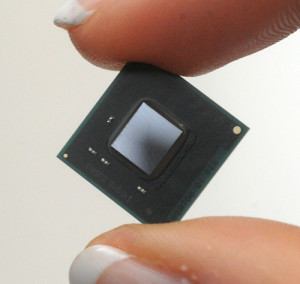 Intel, whose chips have long gone into PCs, servers and mobile devices, has begun chasing the market for the so-called “Internet of things” with new low-power chips and software for connected devices and data-gathering instruments.
Intel, whose chips have long gone into PCs, servers and mobile devices, has begun chasing the market for the so-called “Internet of things” with new low-power chips and software for connected devices and data-gathering instruments.
The company on Tuesday introduced the Atom processor E3800 low-power chip, code-named Bay Trail-I, and the extremely low-power Quark SoC X1000 for devices in the emerging field called the Internet of things, in which instruments like networked devices and sensors exchange data wirelessly or transmit information into the cloud.
“By now we have seen a critical mass of devices being connected,” and that is critical for the Internet of things to become real, said Ton Steenman, vice president and general manager of the Intelligent Systems Group at Intel, during a press conference in San Francisco, which was webcast.
The chips could go into products like vending machines, ATMs, portable medical devices, energy monitors or in-vehicle entertainment systems, Intel said. Products like refrigerators, smartwatches and set-top boxes could also be data-gathering instruments if connected to other devices or the Internet.
Intel also announced “intelligent gateway” products in which the company will supply hardware and software to be used in existing embedded products that may not be connected to the Internet. Steenman said that 85 percent of devices are “built into legacy” and need to be connected. The hardware will have security, connectivity and analytics capabilities to ensure data is safely moved between devices or into the cloud.
Intel assets like the McAfee security platform and the Wind River real-time operating system are key for its embedded chips to securely collect and quickly process data. Wind River’s Intelligent Device Platform adopts the MQTT (Message Queuing Telemetry Transport) protocol for messaging across IOT devices and also builds in support for Wi-Fi, Bluetooth, ZigBee and low-power, short-range wireless protocols.
The new products reflect Intel’s interest in expanding outside the PC arena, said Dean McCarron, principal analyst at Mercury Research.
Any device that could benefit from a networking presence is a potential target for Intel.
“[Internet of things] is nebulous and undefined, but it has been certainly established that it is big,” McCarron said.
Volume shipments won’t happen overnight. But over time, the new products could help keep Intel’s factory busy, McCarron said.
The Bay Trail-I chip is available now, and the Quark and intelligent gateway products will be available in the first quarter of next year. The Quark SoC is a 32-bit x86 CPU with a clock speed of 400MHz, and the chip is also being included in the open-source Galileo computer, which was announced last week and is targeted at the do-it-yourself crowd. The DIY crowd is expected to contribute to the IOT field with small, connected devices that can be used for work and play.
Many IOT devices are based on microcontrollers, but there is a need for faster CPUs like Quark that can collect and process data faster, Steenman said. The power draw of Quark is not yet known.
Intel is still exploring the IOT business opportunity, and it will be a few years before concrete business results show up, Steenman said.
“More devices is good for us as a company,” Steenman said.





